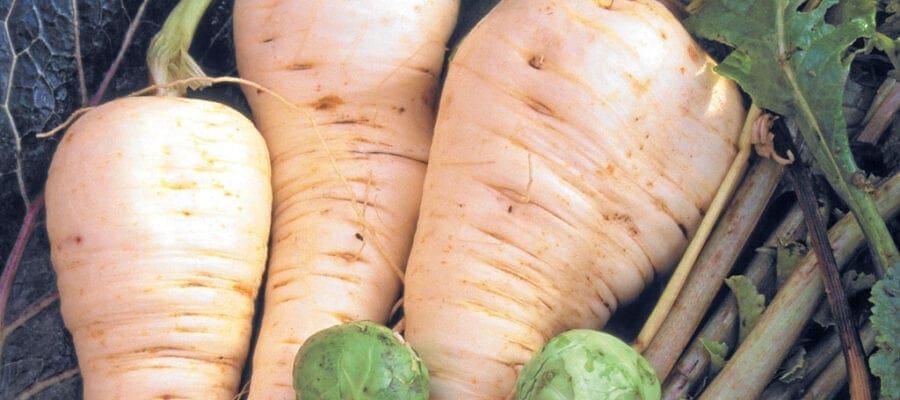Parsnips are a delicious winter veg that’s not difficult to grow once it gets established but it is a crop that is best grown on a large vegetable patch or allotment.
The reason for this is the length of time the crop is in the ground. It is sown in March and not harvested until November at the earliest.
To have enough roots for a decent harvest you need a good area set down to parsnips so space is certainly an advantage.
This said, because parsnips are in the ground a long time, it is possible to sow quicker-maturing crops between their rows, such as lettuce or radish. Sow in May for tender mini roots to harvest in late summer/early autumn.
Varieties
- ‘Avonresister’
This variety can be grown at closer spacings about 7cm (3in) apart. It shows good canker resistance. - ‘Dagger F1’
Has an Award of Garden Merit from the RHS. Smooth roots and good canker resistance – ideal for mini roots. - ‘Gladiator F1’
A hybrid parsnip which means it should produce more uniform plants and roots of excellent quality. Has a lovely smooth white skin and a very sweet flavour. Ideal for exhibition purposes. - ‘Tender and True’
Another popular variety that is good for the kitchen and show bench. Also has reasonable canker resistance. - ‘Javelin F1’
Another variety that can be harvested for mini or full grown roots. - ‘White Gem’
Heavy yields and highly resistant to canker.

Sowing & Growing Parsnips
Prepare the soil well by digging it over deeply to break up any hard layers and also remove any large stones.
There is no need to add manure or heavily feed the ground where parsnips are to grow. The ground should be raked over well to form what is called a fine tilth or a nice crumbly surface.
Put out a line and make a shallow seed drill along it. Water the bottom of the drill well and then sow. Parsnip seed is quite large and easy to handle.
Either sow quite thickly along the row or every couple of inches sow two or three seeds. At least with this method there is a good chance of one of the seeds germinating at each sowing station and you can always remove excess ones that you don’t need.
Growing on parsnips
As the parsnips grow, thin out the plants so there are always gaps in between. Eventually you are aiming for about 15cm (6in) between plants. This will leave room to allow for the foliage and give space for each root to develop.
Remove any weeds regularly and water the crop in dry spells. This is important if you are to get good-sized roots by early winter.
The roots are ready for lifting once the foliage has died down which will be late autumn or the beginning of winter. The roots won’t put on any more growth at this stage.
It is said that the sweetest-flavoured parsnips are those that have experienced a frost or two, but in our milder winters of late, this may not be an option so simply dig up one or two roots as and when required.
Parsnips will happily sit in the ground all winter so no need to lift the whole crop and store elsewhere.
Scrumptious recipes for your homegrown parsnips
More on parsnips
More grow guides
For more growing tips and guides, you should subscribe to Kitchen Garden – you’ll receive free seeds with every single issue too!





